Insect Dyes

Natural red dyes, prior to modern times, were extracted from several sources, including many botanical ones (e.g. madder root was used for dyeing textiles). Brazilwood is said to have been introduced to Ukraine in the 1800s by returning immigrants. The best bright red colors, though, for both pysanky and dyeing cloth, were obtained from Polish cochineal (Porphyrophora polonica), a scale insect also known as Polish carmine scales. This crimson dye produced was known locally in Ukraine as червець (chervets’), and colloquially known as Saint John's blood.
The larvae of P. polonica are sessile parasites living on the roots of various herbs – especially those of the perennial knawel (Scleranthus perennis)– which grow on the sandy soils of Central Europe and other parts of Eurasia. Before the development of aniline, alizarin and other synthetic dyes in the late 1800s, the insect was of great economic importance, although this was declining after the introduction of Mexican cochineal to Europe in the 16th century.
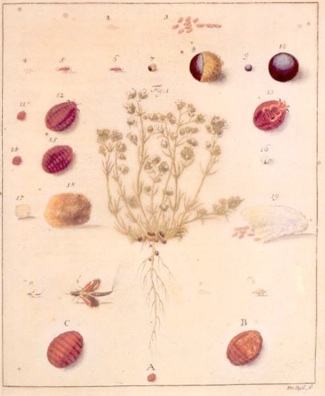
Life Cycle. In mid-July, the female Polish cochineal lays approximately 600-700 eggs in the ground. When the larvae hatch in late August or early September, they do not leave the egg case but remain inside until the end of winter. In late March or early April, the larvae emerge from the ground to feed for a short time on the low-growing leaves of the host plant before returning underground to feed on the plant's roots. At this point, the larvae undergo ecdysis, shedding their exoskeletons together with their legs and antennae, and they encyst by forming outer protective coatings (cysts) within the root tissues. (See diagram on left.)
The cysts are small dark red or violet bubbles clustered on the host plant's roots. Female cysts are 3-4 mm in diameter. Males are half the size of their female counterparts and smaller in number, with only one male per 500 females. The cysts undergo ecdysis a number of times. The females are neotenous, meaning that they retain their larval form even when they reach sexual maturity. The males, when they reach sexual maturity, form a delicate white cocoons and transforms into a pupae in early June.
In late June or early July, females re-emerge from the ground and slowly climb to the top of the host plant. There they wait until winged adult males, with characteristic plumes at the end of their abdomens, leave their cocoons and join them a few days later. Male adults do not feed, and thus they die shortly after mating. Their female counterparts return underground to lay eggs, after which they shrink and die.
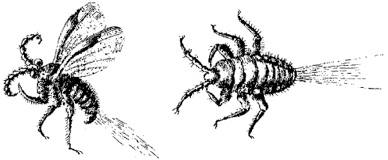
Adult Polish cochineal bugs (male on left)

Host Plants. The Polish cochineal lives on herbaceous plants growing in sandy and arid, infertile soils. Its primary host plant is the perennial knawel (Scleranthus perennis), but it has also been known to feed on plants of 20 other genera, including mouse-ear hawkweed (Hieracium pilosella), bladder campion (Silene inflata), velvet bent (Agrostis canina), Caragana, smooth rupturewort (Herniaria glabra), strawberry (Fragaria) and cinquefoil (Potentilla).
Geographic Distribution. The insect was once commonly found throughout Eurasia, from France and England to China, but it was mainly in Central Europe where it was common enough to make its industrial use economically viable. The distribution map (below) shows areas where cochineal was once found in commercial quantities. Excessive economic exploitation as well as the shrinking and degradation of its habitat have made the Polish cochineal a rare species. In 1994, it was included in the Ukrainian Red Book of endangered species.
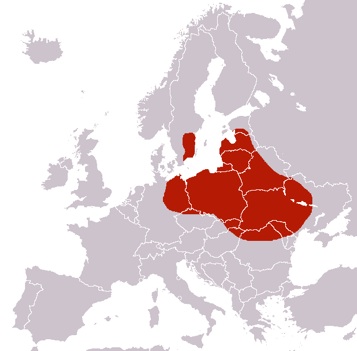
Dye Production. Ancient Slavs developed a method of obtaining red dye from the larvae of the Polish cochineal. Despite the labor-intensive process of harvesting the cochineal and a relatively modest yield, the dye continued to be a highly sought-after commodity and a popular alternative to kermes (a Persian red insect dye) throughout the Middle Ages. Similar to other red dyes obtained from scale insects, the red coloring is derived from carminic acid (with traces of kermesic acid).
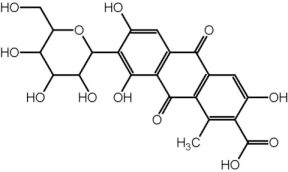
The insects were harvested shortly before the female larvae reached maturity, i.e. in late June, usually around Saint John the Baptist's day (June 24), hence the dye's folk name, “Saint John's blood.” The harvesting process involved uprooting the host plant and picking the female larvae from the roots; they averaged approximately 10 insects from each plant. In Poland, which then included much of present-day Ukraine, and elsewhere in Europe, plantations were operated in order to deal with the high toll on the host plants. (See map above.)
The larvae were killed with boiling water or vinegar, then dried in the sun or in an oven, ground, and dissolved in sourdough or in light rye beer called kvas (квас) in order to remove fat. The extract could then be used for dyeing silk, wool, cotton or linen.

The advent of cheaper Mexican cochineal led to an abrupt slump in the Polish cochineal trade, and the 1540s saw a steep decline in quantities of the red dye produced and exported. Perennial knawel plantations were replaced with grain fields or pastures for raising cattle. Polish cochineal, which had been produced primarily for export, continued to be used locally by the peasants who collected it. It was employed not only for dyeing fabric, but also as a vodka colorant, an ingredient in folk medicine or even for decorative coloring of horses' tails.
With the partitions of Poland at the end of the 18th century, large areas of Ukraine fell under Russian rule, and vast markets in Russia and Central Asia opened to Polish cochineal, which became an export product again – this time, to the East. In the 19th century, Bukhara, Uzbekistan, became the principal Polish cochineal trading center in Central Asia; from there the dye was shipped to Kashgar in Xinjiang, and Kabul and Herat in Afghanistan. It is possible that the Polish dye was used to manufacture some of the famous oriental rugs.
Lingusitics. The historical importance of Polish cochineal is still reflected in most modern Slavic languages where the words for the color red and for the month of June (and sometimes July) derive from the Proto-Slavic *čьrvь , meaning "a worm" or "larva".
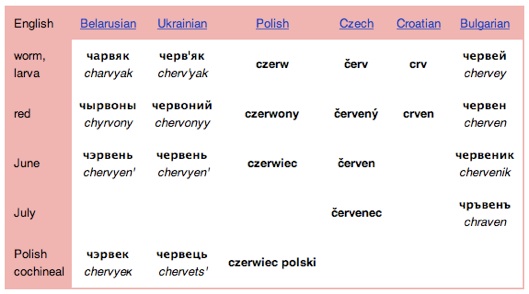
In the Ukrainian language, червень (cherven’) is the word for June, черв’як (chervyak) is he word for worm/larvae, and червець (chervets’) is the word for Polish cochineal .
(Note: large sections of this page, albeit edited, and most of the illustrations, have been taken from Wikipedia.)
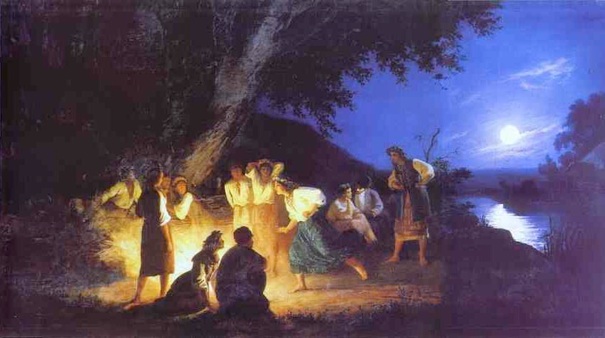
A scene from the celebration of Kupalo, the midsummer holiday which falls on modern St. John's day in June
Back to Main Dyes page
Back to MAIN Pysanka home page.
Back to Pysanka Index.
Search my site with Google
Cochineal

Female Polish cochineal bug
Porphyrophora polonica



